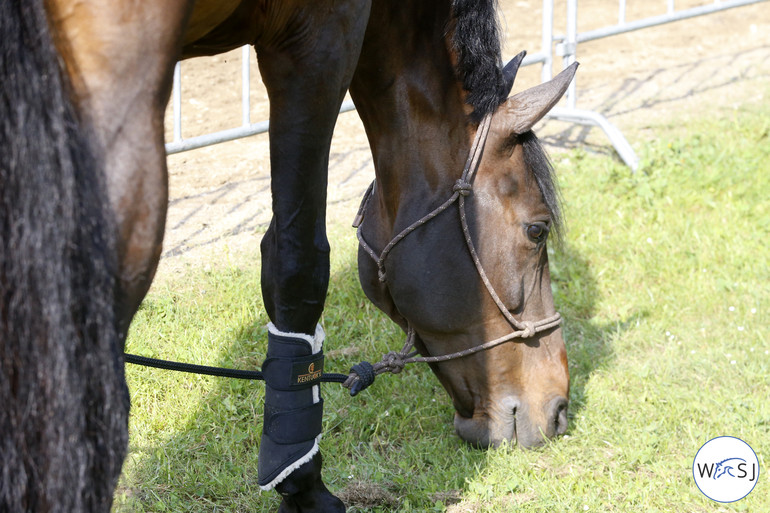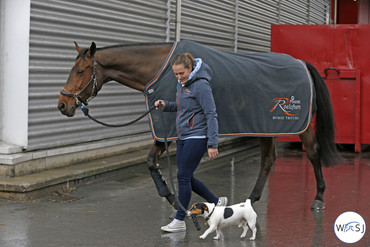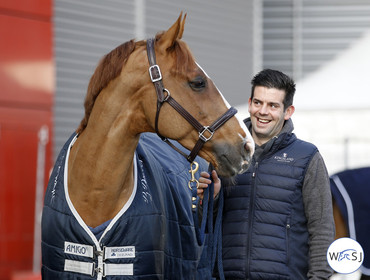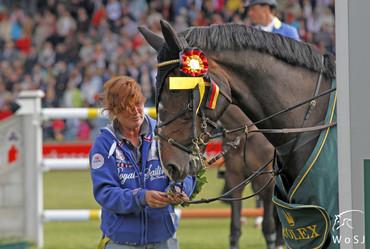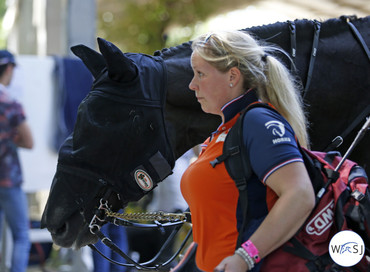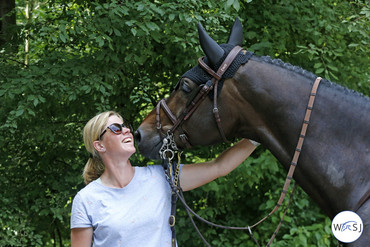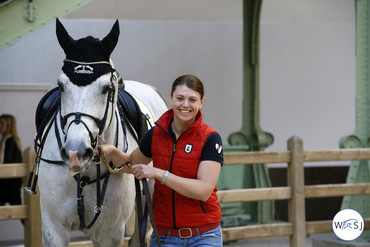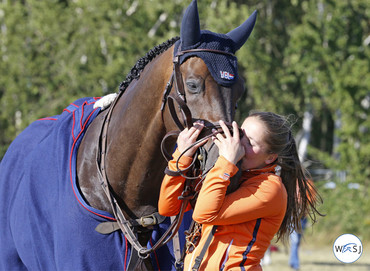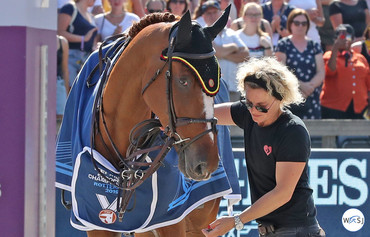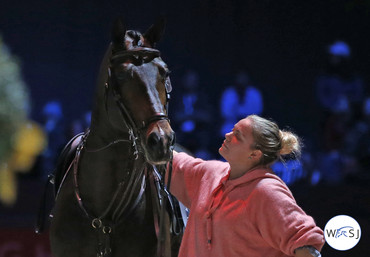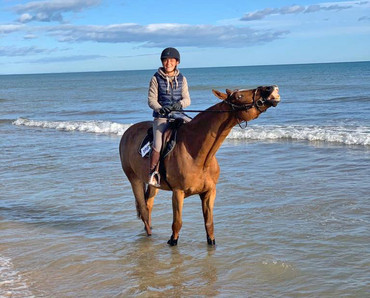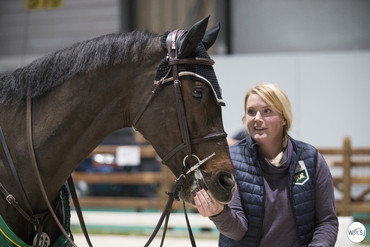World of Showjumping asked several highly experienced grooms to share their best tips & tricks. In this next part of our series, the grooms share their preferable protection for the field and when transporting the horses.
Morgane Tresch, long-time groom for Jeroen Dubbeldam:
“When we put the horses in the field, we use boots on all four legs and bell boots on the front legs. For lunging we use the same protection.
During travelling, I use traveling boots or stable bandages. Some horses don’t like to have anything on their hind legs, so I prefer not to use any protection there – especially when you have a long trip to the show. If the horse is kicking during the travel, your protection or bandages can go completely down the leg.”
Sean Lynch, long-time groom for Daniel Deusser:
“For the field, all our horses wear front boots, back boots and over-reach boots and all the products are from our great sponsor Back on Track.
For travelling, we use bandages and over-reach boots. If they have bandages just in front or on all four legs depends on the horse. When flying, I always put a kick-pad behind the horse even if they don’t need it. It is very different for a horse to travel in a plane, so if they don’t wear protection behind on the plane I like to try to prevent accidents if I can.”
Cynthia Gurrie, former long-time groom for Michael Whitaker:
“For local day shows we would normally just use travel boots in front. When going to these shows we could have three trucks with about twenty horses leaving at the same time, so it was much easier with travel boots. For international shows and travels abroad, I would always use travel bandages and depending on the horse some might be bandaged all around and some just in the front.
For the field, most our horses were turned out in front and back boots. Some would only have front boots, but every horse would wear over-reach boots in case they pulled a shoe off.”
Fran Callan, former long-time groom for Jur Vrieling, now working for Jos Verlooy:
“When travelling, I would ideally like every horse to have bandages and bell boots in the front for protection. However, some horses don’t like the bandages, so I let them travel with nothing on. For some people this can be terrifying, but I feel that if the horse stands quietly without the bandages it is the best for them to travel this way.
For flying I try not to complicate it and use what the horses are used to. I feel that it is not a good time to introduce something new when in the air. Keep it simple and keep it related to each horse’s needs. There is no right and wrong and every groom does it differently. We never stop learning and my main concern is to keep the horses happy, healthy and comfortable.
We use EquiFit’s boots for jumping, walker work, training, travelling, for the field and in the ring – for me it is the best brand on the market.”
Madeleine Broek, long-time groom for Marc Houtzager:
Josie Eliasson, long-time groom for Jessica Springsteen:
“For the field we typically put on front boots – Back on Track has great boots that you wrap around the leg for full lower leg protection. We also always put a bell boot on in case they are a bit excited in the field and then hopefully all shoes will stay on. If I have a horse that I know can be a bit wild on the field or easily catches itself behind, I also put a little hind boot on.
I use a hand-walking boots for the walker, treadmill etc.
When we travel the horses, I like to bandage them with stable wraps, preferable on all four legs but this depends on the horse. I also like to put bell boots on in front.
In the crate for the plane, I only put bandages behind if I know that they are completely comfortable with it. If they start to kick because of the bandages during the flight, there is no chance to safely get into that part of the crate to get them off."
Malin Henlöv, former long-time groom for Peder Fredricson, now working for Evelina Tovek:
“For the field we use front boots and bell boots if necessary. We very rarely use boots behind, and it is only if we have a very wild horse or a very clumsy horse.
For short travels I use travel boots or stable boots like the ones from Back on Track. For longer travels the horses get bandages all around if they are comfortable with that, if not they only get bandages in front then bell boots with fluff if needed.“
Kay Neatham, former long-time groom for Marcus Ehning:
Aurelie Marchiando, former long-time groom for Leopold van Asten:
“In the field we have protection both in the front and behind plus bell boots.
For the transport, we have bandages and bell boots in the front and bandages behind on most horses, but I have a few horses without anything behind because they travel better like this. Here you have to listen to your horses and make them as comfortable as they want to be.”
Jenny Ducoffre, long-time groom for Jos Verlooy:
Nickki O’Donovan, long-time groom for Darragh Kenny:
“For the paddock I put fluffy front brushing boots, bell boots and hind fetlock boots on. When hand-walking I also uses fluffy brushing boots.
When I travel, I put fluff on the halters to prevent rubs. Then front bandages that come to the knee plus bell boots. Some horses will get back bandages also, if I know they will kick. But since I travel alone a lot, I try not to put any protection behind – if a bandage slips it’s not easy to fix it yourself and there is a big risk of getting injured.”
Marlen Schannwell, long-time groom for Bertram Allen:
“For the fields we use soft Neopren overreach boots and breathable brushing boots (eventing) in front to prevent rubs and overreaches. In case the horses stay out longer than half a day or overnight they go without anything to make sure not to get boot rubs.
For travelling I use Neopren stable boots with a long thick, soft pad that goes over the hoof as well. Like this, the horses are comfortable and are protected from the knee to the hoof and even when they scratch or try to chew on it, nothing can go wrong or slide like bandages.”
Lena Laub, long-time groom:
“What protection I choose depends on the horse, but in the field I would normally use front boots and bell boots. For the transport I like to have the older horses in four bandages when it is a longer trip. My experience is that younger horses don’t always like bandages behind and they travel much better without anything on the hind legs.”
Denise Moriarty, long-time groom for Kent Farrington:
“I use boots and bell boots for those that need them for turnout. If they stay out overnight, they just get bell boots on.
For travel I use front bandages, bell boots and hind bandages for those that stock up on long trips - as long as they are not kickers. For shorter trips I use Back on Track Quick Wraps.”
No reproduction without written permission, copyright © World of Showjumping



